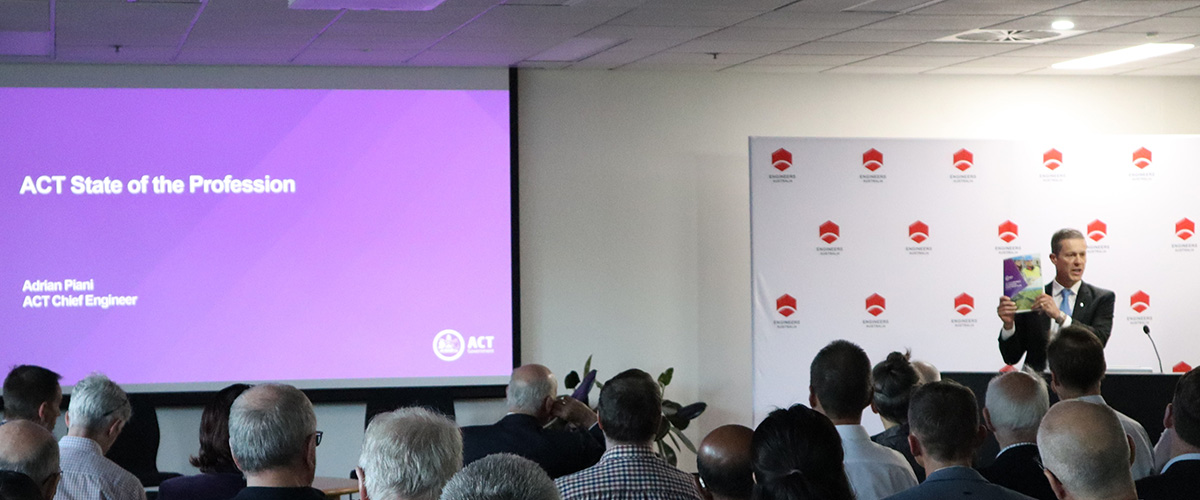Engineers Australia hosted its first ACT State of the Profession evening to give engineers a snapshot of what the profession looks like today.
We’ve wrapped up some of the key pieces of information in presentations from Chief Engineer for Engineers Australia Jane MacMaster and ACT Chief Engineer Adrian Piani.
As a foundation for the discussion, Engineers Australia consolidated data from the 2021 census to gain insights and identify where we can make the most difference as a professional organisation. The data presented was a small preview, ahead of making the data more widely available later this year.
The ACT has a 10,000 person-strong potential workforce of engineers. In the ACT the primary employer of engineers is public administration and safety, which employs 35 per cent of the labour force, almost half of those engineers work in defence. This is followed by professional, scientific and technical services, which employs 23 per cent of engineers, then construction employs six per cent. The remaining 64 per cent of ACT engineers are employed in everything from education to arts and recreation.
Census data provides us with some sobering insights; in August 2021 there were only 171 unemployed qualified engineers in the ACT, with 96 engineering vacancies recorded by Jobs & Skills Australia for that month (1.78 potential applicants per vacancy).
National insights
Jane MacMaster highlighted Australia is in one of its largest ever skills shortages, with the unemployment rate sitting at 3.7 per cent (January 2023), a 49-year low.
MacMaster said 92–95 per cent of construction, engineering, manufacturing, technology and mining employers report difficulties with skills shortages. As for engineering employers, 82 per cent believe skills shortages will impact operations or growth.
One of the reasons for these skill shortages is that while Australia is heavily dependent on skilled migrants for engineering, skilled migrant engineers have poor employment outcomes compared to Australian born engineers. Only 45 per cent of female overseas born engineers and 51 per cent of overseas born males are in engineering occupations. This is compared to 61.9 per cent of female Australian-born engineers and 65 per cent of Australian-born male engineers.
Engineering registration is another priority for the profession in 2023. National consistency of registration schemes is of paramount importance to industry and regulators and Engineers Australia has been advocating for national consistency.
The ACT has introduced a statutory Professional Engineers Bill to the Legislative Assembly, which is due to be debated this Thursday (23 March) and implemented in the early stages of 2024.
Canberra insights
Adrian Piani, the ACT Chief Engineer, delivered the state of the profession for Canberra.
Piani said the ACT Government have approximately 250 engineers in the ACT public service, made up of 50 per cent civil engineers, 12 per cent environmental and nine per cent electrical. The Chief Engineer’s workforce is continuing to increase its percentage of female engineers with a target of at least 25 per cent.
With engineering registration set to be debated in parliament later this week, national consistency and mutual recognition with other jurisdictions will be key considerations. Once the registration Bill has been ratified the regulations and guidelines will continue to be improved and Engineers Australia will be a key stakeholder in the development of the Bill.
Other major engineering works in the ACT include a transition from gas to electrification and the move to a circular economy.
Piani said this year the territory government is developing an Integrated Energy Plan, due to be released in mid-2023 with a final version in early 2024. Key considerations of the plan will include supporting households with lower incomes, transitioning complex buildings, opportunities for the workforce and economy and the role of batteries and electric vehicles.
The ACT Government has been working on championing principles of a circular economy; designing out waste and pollution, keeping materials in use, and prioritising regenerative resources. Recently the Northbourne Avenue road surface rehabilitation used 6000 tonnes of recycled materials, reducing new imported materials to site by 69 per cent. The new FOGO industrial composting facility will also contribute to this shift by recycling organic waste to create nutrients for plant, garden and agricultural soil.
Infrastructure is another priority for the ACT Government. The Canberra Light Rail, the CIT Campus in Woden, and Canberra Hospital Expansion are examples of major projects in the state that rely heavily on engineers. Piani emphasised working to achieve net zero emissions on these projects is now just “a requirement of what we [engineers] do”.
Engineers Australia Canberra plan to host the State of the Profession evening annually. Keep an eye out in Engineering News and on the Canberra EAXchange community for events and local updates.

